SoHE renovation: A world of textiles, a sea of boxes
Each August, as apartment leases turn over in downtown Madison, thousands of students pack up their belongings to move. Some fold neatly into labeled boxes; some discard as they go. Others simply shove clothes into trash bags, using them as pillows overnight.
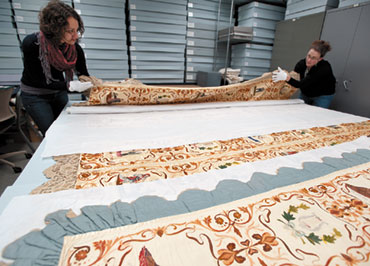
Assistant curator Diana Zlatanovski (left) and curatorial assistant Tara Genske carefully layer tissue and fold (see above and below for the process) a late 19th-century French opera quilt at the Helen Louise Allen Textile Collection in the Human Ecology Building. The quilt is one of the larger items in the School of Human Ecology’s 13,000-piece textile collection being packed for temporary relocation to an off-site preservation facility during construction of a Human Ecology Building addition, which is set to begin in 2010.
Photos: Jeff Miller
For Diana Zlatanovski and Maya Lea, the job is a little more complicated.
As collection manager and curator, respectively, of the Helen Louise Allen Textile Collection at the School of Human Ecology (SoHE), Zlatanovski and Lea have spent the last several months packing up 13,000 museum-quality textiles: rugs, fabrics, hats, quilts and more. During SoHE’s extensive renovation process, scheduled to begin in January, the collection will move to an off-campus storage facility.
How the pieces get there, and what happens next, may be as interesting as the textiles themselves.
Best known for its many examples of ethnographic textiles, both functional and beautiful, the HLATC is primarily a teaching collection, rarely on view for the public.
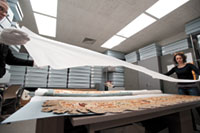
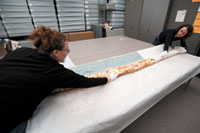
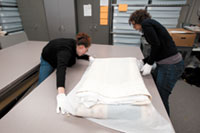
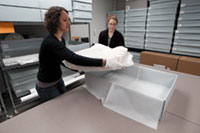
“This project has really let me see so much more of it,” says Zlatanovski. “With 13,000 pieces, I wish it were my job to just look through the cabinets all the time. You just don’t usually get this opportunity.”
On a recent afternoon, the staff prepared an “opera quilt,” so named for the intricate embroidery depicting scenes from works by Puccini and Verdi. This exquisite piece, rumored to have won first prize at the 1900 World’s Fair, was made by French nuns.
“We had to jimmy-rig some boards to hold up one side of it,” says Zlatanovski. “Unfolded, it was bigger than our entire table. The quality of it, the detail and the fact that it was so old and in beautiful condition… its life before it got here must have been so exciting.”
Those handling the textiles wear white gloves, touching the works as little as possible. Because folding can create points of stress, leading to possible tears or weaknesses in already-delicate work, the pieces are stored flat.
This poses a challenge with something like the opera quilt, which measures a staggering 10 feet by 9 feet. Before nestling the quilt inside a tissue-lined storage box, workers padded the piece, shaping it into gently draped curves, not sharp creases.
For other pieces, however, the process is not so straightforward. A black Hattie Carnegie hat from the 1950s, a favorite example for SoHE’s 3-D patternmaking class, needed to be easily accessible while retaining adequate protection — all without damaging the exuberant feathered brim. Using foam, muslin and layers of coroplast board, graduate assistant Tara Genske created a custom box, forming a sturdy stand inside that allowed the hat to be pulled out without touching the piece itself.
Zlatanovski documented the entire process on her blog.
“Now when the piece needs to be displayed for a class, we simply use the handles to pull the entire tray out of the box, never having to touch the hat,” she wrote on Sept. 15. “We imagine all those little feathers are thanking us.”
This blog, created to document the moving process, has become an integral part of the collection’s teaching mission. It serves multiple purposes. Most crucially, it draws in curious visitors who might not know of the collection’s existence.
“We’re in an esoteric field at a Midwestern campus, with no parking, so we’re hard to get to,” says Lea. “We try as much as we can to help with requests to see pieces, but obviously for the next two or three years, there’s only so much we can do.
“Diana’s blog is great because people who wouldn’t have searched for us are finding their way to her blog in other ways. It’s so appealing, so beautiful and accessible.”
Zlatanovski also created the blog as a resource for others in her position, many of whom may face similar difficulties when dealing with unique, oddly shaped objects.
“There’s not a go-to bible for how to do this; there’s a fair amount of research that has to go into how to pack a three-dimensional whatever-it-is,” says Zlatanovski. “Providing photos of it along the way will, I hope, help other collection managers and museums. Maybe showing these multiple ways can spark an idea: ‘Oh, we could use this material in a different way!’”
The blog is one way the collection plans to staying active over the next two to three years. Some of the more popular teaching pieces have been set aside in the Interim Teaching Collection (ITC for short), so that classes can still access them easily.
Although new acquisitions remain suspended during this time, Zlatanovski will continue photographing and cataloguing the collection in its offsite facility. Lea will research and prepare exhibitions, including those for the new African wing of the Chazen Museum of Art.
In perhaps the most exciting step for the collection, more than half of its holdings are now available for viewing online. Lea doesn’t mince words about the impact of this move, both for the collection’s profile and the textile world.
“When I was at the Philadelphia Museum of Art, I found that online databases were woefully lacking in textiles — maybe 15–20 textiles out of tens and tens of thousands of images,” says Lea. “By putting our collection online, we would be the dominant textile presence in the art historical community.”
As the blog attracts national recognition for deft handling during this move, it has also attracted museum professionals excited to see what comes next. When the collection emerges from hibernation, it will move from a corner of SoHE’s third floor to a prime space near the new entrance and Design Gallery. Display cases will line the hallway, with innovative drawers allowing curators to both make textiles accessible to the public and swap out pieces as needed.
The collection’s enhanced prominence honors the way that humans interact with textile pieces: wearing, displaying and creating functional, beautiful works of art. This much-needed visibility is a testament to the dedication of staff, volunteers and supporters, many of whom love to create textiles themselves.
“Here in Madison – and this is not true in other parts of the country – people are very hands on,” says Lea. “We’re really lucky to be embedded here and have the opportunity to show off to people who are already converts to how wonderful this kind of art is.”
Tags: arts
